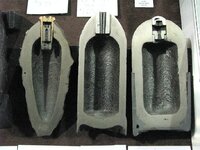Senator Blutarski
Tenderfoot
- Jan 31, 2016
- 7
- 17
- Detector(s) used
- Tesoro Sand Shark
- Primary Interest:
- All Treasure Hunting
Looking for some help identifying what appears to be two smoothbore shot shells. 5in in diameter with a pronounced flathead screw plug (perhaps fuse). NOT round but flat on backside with approx a 3/4 in hole in middle. From flat part to round end (where plug is) is 3.5 in.
Found this weekend in close proximity to FL civil war battlefield. Can't find any reference comparison on the Internet or my other usual research
Thank you!



Found this weekend in close proximity to FL civil war battlefield. Can't find any reference comparison on the Internet or my other usual research
Thank you!



Last edited:








